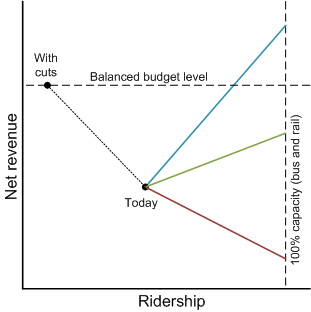Do more riders cost Metro more?
Metro is facing a $176 million budget shortfall, for 13% of their total. To avoid a fare hike, WMATA officials are planning major budget cuts and an estimated $87 million in service cuts. They haven’t yet decided which service to recommend cutting. The Examiner’s Kytja Weir asked WMATA board member Peter Benjamin why Metro doesn’t have more money thanks to its recent record ridership. His response, or Weir’s explanation of his response, is puzzling:
More riders, paying more fares, doesn’t actually help. “Every rider in the system is subsidized,” explained Peter Benjamin, a Metro board member who used to be the agency’s chief financial officer. “As more people ride, it costs us more.”
Metro has certain fixed costs (like maintaining its physical infrastructure), certain costs that depend on the level of service (like paying bus drivers, and electricity for trains) and certain costs that depend on the number of riders (like cleaning). I’d always thought that the incremental revenue they get from each rider exceeds the costs in the third category, meaning that more riders do make Metro more money, but that the costs all combined still exceed the revenue. A record ridership year could blunt Metro’s financial deficit, but not erase it.
Benjamin’s quote, on the other hand, suggests that each new rider actually costs Metro more money. The graph below illustrates the difference:

Currently, Metro has a certain ridership level and earns a certain amount of revenue (the black dot marked “today”). It’s below the balanced budget line, reflecting the current deficit. According to last week’s board presentation, Metro expenses rose $159 million because of labor costs, energy, declines in their pension investments, and rising MetroAccess costs. Also, according to the Examiner article, “parking fees and rental properties are bringing in less money.”
If the per-rider marginal costs are negative (as the Examiner article says), then the red line shows the relationship between more riders and revenue. More riders only cost more money. If the marginal costs are positive, then more riders help Metro, but maybe not enough to close their current budget gap. Possibly even full 100% capacity is not going to get Metro the $176 million they need (the green line). More riders still relieve the deficit, but not enough to eliminate it altogether. The blue line shows a scenario where, if Metro got enough riders, they’d actually plug their budget hole.
Of course, this oversimplifies the situation. More riders off-peak are better than at rush hour, because there’s more capacity to spare. Some riders travel farther, and some lines recover more of their revenue than others. (Bus lines recover less than rail lines in general.)
So what’s the answer? It appears that the article or the quote is misleading. The board presentation says that revenue is down $17 million, but not because of riders. “Ridership growth is generating significant revenue growth, but not enough to offset other revenue decline,” it says. That other decline must be the rental and parking fee revenue the Examiner mentions. Benjamin used to be Metro’s CFO, so he surely knows the reality of Metro’s costs and revenues. Most likely, if the quote is accurate, he was simplifying the situation to make it clearer to readers.
Too much simplicity, though, and people are prone to translate “every rider is subsidized” into believing that more Metro ridership hurts the system. Adding housing near Metro trains or buses reduces the subsidies we have to give WMATA. TDM programs that encourage ridership do the same. And free and/or excessive parking policies, which make driving more appealing than riding Metro, hurt us all financially.
Metro may have to cut service to balance its budget now (the “with cuts” dot). But as you can see from the graph, there’s another longer-term possibility: increase ridership more. If we’d had even more ridership than we do, perhaps we wouldn’t need these cuts. Perhaps revenue growth would have not only offset the rental and parking fee declines but covered some or all of the $159 million in expenses. The more we can encourage transit riding through our transportation and land use policies, the less likely Metro is to cut service or raise fares.
